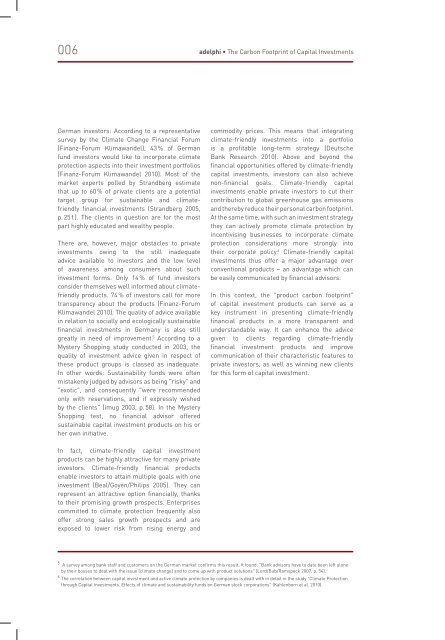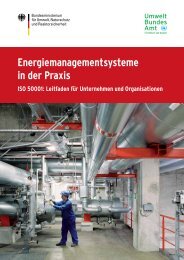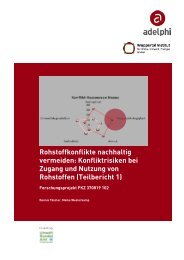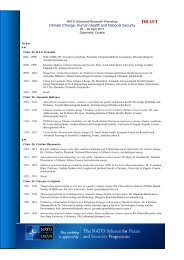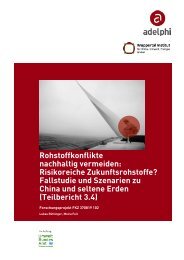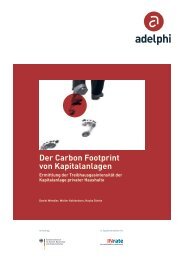The Carbon Footprint of Capital Investments - adelphi
The Carbon Footprint of Capital Investments - adelphi
The Carbon Footprint of Capital Investments - adelphi
Create successful ePaper yourself
Turn your PDF publications into a flip-book with our unique Google optimized e-Paper software.
006 <strong>adelphi</strong> • <strong>The</strong> <strong>Carbon</strong> <strong>Footprint</strong> <strong>of</strong> <strong>Capital</strong> <strong>Investments</strong> <strong>adelphi</strong> • <strong>The</strong> <strong>Carbon</strong> <strong>Footprint</strong> <strong>of</strong> <strong>Capital</strong> <strong>Investments</strong><br />
007<br />
3 Financed emissions – the product carbon<br />
footprint <strong>of</strong> capital investments<br />
German investors: According to a representative<br />
survey by the Climate Change Financial Forum<br />
(Finanz-Forum Klimawandel), 43 % <strong>of</strong> German<br />
fund investors would like to incorporate climate<br />
protection aspects into their investment portfolios<br />
(Finanz-Forum Klimawandel 2010). Most <strong>of</strong> the<br />
market experts polled by Strandberg estimate<br />
that up to 60 % <strong>of</strong> private clients are a potential<br />
target group for sustainable and climatefriendly<br />
financial investments (Strandberg 2005,<br />
p. 25 f.). <strong>The</strong> clients in question are for the most<br />
part highly educated and wealthy people.<br />
<strong>The</strong>re are, however, major obstacles to private<br />
investments owing to the still inadequate<br />
advice available to investors and the low level<br />
<strong>of</strong> awareness among consumers about such<br />
investment forms. Only 14 % <strong>of</strong> fund investors<br />
consider themselves well informed about climatefriendly<br />
products. 74 % <strong>of</strong> investors call for more<br />
transparency about the products (Finanz-Forum<br />
Klimawandel 2010). <strong>The</strong> quality <strong>of</strong> advice available<br />
in relation to socially and ecologically sustainable<br />
financial investments in Germany is also still<br />
greatly in need <strong>of</strong> improvement. 5 According to a<br />
Mystery Shopping study conducted in 2003, the<br />
quality <strong>of</strong> investment advice given in respect <strong>of</strong><br />
these product groups is classed as inadequate.<br />
In other words: Sustainability funds were <strong>of</strong>ten<br />
mistakenly judged by advisors as being "risky" and<br />
"exotic", and consequently "were recommended<br />
only with reservations, and if expressly wished<br />
by the clients" (imug 2003, p. 58). In the Mystery<br />
Shopping test, no financial advisor <strong>of</strong>fered<br />
sustainable capital investment products on his or<br />
her own initiative.<br />
In fact, climate-friendly capital investment<br />
products can be highly attractive for many private<br />
investors. Climate-friendly financial products<br />
enable investors to attain multiple goals with one<br />
investment (Beal/Goyen/Philips 2005). <strong>The</strong>y can<br />
represent an attractive option financially, thanks<br />
to their promising growth prospects. Enterprises<br />
committed to climate protection frequently also<br />
<strong>of</strong>fer strong sales growth prospects and are<br />
exposed to lower risk from rising energy and<br />
commodity prices. This means that integrating<br />
climate-friendly investments into a portfolio<br />
is a pr<strong>of</strong>itable long-term strategy (Deutsche<br />
Bank Research 2010). Above and beyond the<br />
financial opportunities <strong>of</strong>fered by climate-friendly<br />
capital investments, investors can also achieve<br />
non-financial goals. Climate-friendly capital<br />
investments enable private investors to cut their<br />
contribution to global greenhouse gas emissions<br />
and thereby reduce their personal carbon footprint.<br />
At the same time, with such an investment strategy<br />
they can actively promote climate protection by<br />
incentivising businesses to incorporate climate<br />
protection considerations more strongly into<br />
their corporate policy. 6 Climate-friendly capital<br />
investments thus <strong>of</strong>fer a major advantage over<br />
conventional products – an advantage which can<br />
be easily communicated by financial advisors.<br />
In this context, the "product carbon footprint"<br />
<strong>of</strong> capital investment products can serve as a<br />
key instrument in presenting climate-friendly<br />
financial products in a more transparent and<br />
understandable way. It can enhance the advice<br />
given to clients regarding climate-friendly<br />
financial investment products and improve<br />
communication <strong>of</strong> their characteristic features to<br />
private investors, as well as winning new clients<br />
for this form <strong>of</strong> capital investment.<br />
While there are many instruments to measure the<br />
financial performance <strong>of</strong> conventional investment<br />
products, there are as yet few means <strong>of</strong> measuring<br />
extra-financial performance. All clients have to<br />
go on at present with standardised financial key<br />
performance indicators, which give no indication<br />
as to whether their investment strategy will also<br />
achieve extra-financial goals, such as reducing<br />
greenhouse gas emissions (Pictet 2008, p. 8 ff.).<br />
Calculation <strong>of</strong> the product carbon footprint<br />
<strong>of</strong> capital investment products can create<br />
transparency on the market and satisfy the<br />
information needs <strong>of</strong> interested investors. <strong>The</strong><br />
product carbon footprint originates from the<br />
concept <strong>of</strong> the ecological footprint (Wackernagel /<br />
Rees 1996) which has become very popular within<br />
the framework <strong>of</strong> the climate debate over recent<br />
years. <strong>The</strong> product carbon footprint indicates the<br />
greenhouse gas emissions <strong>of</strong> goods or services.<br />
It depicts the emissions throughout the supply<br />
chain, from production to distribution, though it<br />
may also encompass use, disposal and recycling<br />
(ISA UK 2007). Consumers can thus be provided<br />
with a transparent picture <strong>of</strong> the impact on the<br />
earth's climate <strong>of</strong> the products they consume.<br />
This <strong>of</strong>fers them the possibility to incorporate the<br />
product's emissions as decision-making criterion<br />
when choosing which products to buy. <strong>The</strong> product<br />
carbon footprint can ultimately serve as a guide to<br />
responsible consumer behaviour.<br />
No internationally recognised standard currently<br />
exists for determining the product carbon<br />
footprint. A large number <strong>of</strong> initiatives are,<br />
however, campaigning for government or privatesector<br />
product marking to be introduced. <strong>The</strong> basis<br />
<strong>of</strong> all product-related greenhouse gas emission<br />
assessments is the eco-balance according to<br />
the ISO standard 14040 (ISO 14040 ff.). It is very<br />
generalised, however, and in practice the different<br />
methods applied frequently produce results which<br />
are difficult to compare (Öko-Institut 2009). 7<br />
<strong>The</strong> greenhouse gas emissions <strong>of</strong> businesses<br />
are mainly recorded in accordance with the<br />
internationally recognised reporting standard<br />
<strong>of</strong> the GHG Protocol (WRI/WBCSD 2004). For<br />
production emissions (Scope 1) and indirect<br />
emissions, such as due to electricity purchasing<br />
(Scope 2), this standard and the data collection<br />
methodology applied by the companies concerned<br />
are relatively well developed, whereas for<br />
emissions arising from the rest <strong>of</strong> the value<br />
creation chain (Scope 3) there is an urgent need<br />
for more development. <strong>The</strong>se Scope 3 emissions<br />
are only recorded by a minority <strong>of</strong> companies.<br />
Consequently, in early 2010 the World Business<br />
Council for Sustainable Development (WBCSD)<br />
and the World Resource Institute (WRI) initiated<br />
two new provisional standards: the "Product Life<br />
Cycle Accounting and Reporting Standard" and the<br />
"Scope 3 (Corporate Value Chain) Accounting and<br />
Reporting Standard" (WRI/WBCSD 2009a), which<br />
are currently undergoing testing by 60 members<br />
<strong>of</strong> the WBCSD and are scheduled to be presented<br />
in final versions in late 2010 (WRI/WBCSD 2009b).<br />
No German company is so far participating in<br />
this project however, and internationally only one<br />
financial services provider – Bank <strong>of</strong> America – is<br />
represented.<br />
Financial services providers and society at large<br />
are mostly agreed that both investors and finance<br />
recipients are responsible for the social and<br />
ecological effects <strong>of</strong> the financed projects and<br />
enterprises. <strong>The</strong>re are consequently a number <strong>of</strong><br />
initiatives in the financial sector which are already<br />
committed to more concerted consideration <strong>of</strong><br />
such factors in the investment decision-making<br />
<strong>of</strong> financial services providers. As part <strong>of</strong> that<br />
commitment, the world's largest project financing<br />
entities signed up to the Equator Principles (2006),<br />
whereby they undertake to consider sustainability<br />
criteria in respect <strong>of</strong> projects with capital costs<br />
exceeding 10 million US dollars which may have<br />
significant ecological and social impact. Beyond<br />
that commitment, too, widespread efforts are<br />
being made by financial services providers<br />
worldwide to positively influence the social and<br />
ecological effects <strong>of</strong> capital funding provided.<br />
5 <br />
A survey among bank staff and customers on the German market confirms this result. It found: "Bank advisors have to date been left alone<br />
by their bosses to deal with the issue [climate change] and to come up with product solutions" (Lord/Bub/Ramspeck 2007, p. 54).<br />
6 <br />
<strong>The</strong> correlation between capital investment and active climate protection by companies is dealt with in detail in the study "Climate Protection<br />
through <strong>Capital</strong> <strong>Investments</strong>. Effects <strong>of</strong> climate and sustainability funds on German stock corporations" (Kahlenborn et al. 2010).<br />
7<br />
<strong>The</strong> <br />
most influential standard at present is the UK's Publicly Available Specification 2050 (PAS 2050) which is likewise based on ISO 14040 but<br />
also differs from it widely in some points.


